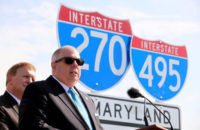Before 2020 and the arrival of the coronavirus pandemic, public-private partnerships in the U.S. had evolved far beyond their one-of-a-kind transportation infrastructure origins, with agencies and institutions of all sizes applying the P3 delivery method to a variety of construction, operations and maintenance projects.
Now, faced with pandemic-related revenue shortfalls and the potential of even tighter budgets, could the use of P3s expand even further? Or will public agencies, saddled with lower revenues, not have the funds to hold up their end of such agreements?
To be sure, the full extent of the pandemic’s economic upheaval has yet to be determined. For example, many transportation departments that saw revenue from fuel taxes and transit ridership virtually evaporate during early-2020 lockdowns have experienced a rebound in succeeding months, albeit well below the previous year’s levels. The prospect of additional federal stimulus aid could also help states regain a sense of fiscal equilibrium until the hoped-for post-pandemic recovery takes hold.
When it comes to planning for the future, however, states appear to be erring on the side of caution. A November 2020 National Governors Association report on transportation funding during COVID-19 cited a nearly $3-billion cut in Maryland’s six-year capital budget for transportation, two-thirds of which was attributed to the coronavirus pandemic. California likewise projected that a return to pre-pandemic transportation revenue levels would take four to five years.
“Given the havoc that the COVID-19 pandemic has inflicted on governmental budgets, public agencies will be forced to be innovative out of necessity.”
—Gregory Ciambrone, President, Walsh Investment Group
Many higher education institutions face a similar budget dilemma. The shift to online learning has brought both added expenses and reduced revenue from absent or decreased on-campus populations that may never fully recover. Studies suggest that international student enrollment, another reliable source of revenue for larger universities, could decline as well in the next few years. Pandemic-strained state budgets could likewise drain school resources, with universities from Illinois to Wyoming announcing possible cutbacks.
Although a P3 typically requires a significant amount time to take shape before reaching the market, the lingering uncertainty of when—or if—public revenue streams will return to 2019 growth rates would appear to enhance the appeal of P3 delivery. Some industry leaders believe it’s an option no agency can afford to pass up.
“Given the havoc that the COVID-19 pandemic has inflicted on governmental budgets, public agencies will be forced to be innovative out of necessity,” says Gregory Ciambrone, president of Walsh Investment Group, the investment and development arm of Walsh Construction’s parent company, Walsh Group. As a result, he adds, “DOTs will be looking at all available options to deliver their critical infrastructure projects.”
Gilbane Building Co. Executive Vice President Paul Choquette III agrees: “We saw the P3 model maturing before the pandemic, so it’s natural to expect an uptick in awareness and interest.”
Other Motivations
On the other hand, Scott Zuchorski, managing director and head of North America Infrastructure and Project Finance for Fitch Ratings, believes the pandemic won’t be the sole motivation for agencies to explore alternative-delivery options. “It’s going to depend on their needs and experiences,” he says. “Those who’ve had challenges with P3s may not be eager to increase their use.”
While the pandemic may not spark a rush of new P3 procurements, most industry observers think it could accelerate use of the delivery method where it is already well established—tolled roads and bridges, bundled transportation construction and maintenance projects, and social infrastructure such as college dormitories and other public facilities. Airports, energy and municipal water systems could also become part of the mix.
Michael Grabham, vice president of energy and infrastructure solutions for Seattle-based construction engineering firm McKinstry, suggests P3s might also become an attractive way for agencies to step up sustainable infrastructure efforts. “With many agencies and institutions making a push for sustainable infrastructure, a P3 would be a viable way to achieve those goals,” he says. “For example, infrastructure projects for fleet conversion to electric or CNG [compressed natural gas] vehicles could be bundled together, as could renovations to bring buildings up to modern energy standards.”
“There’ll be fits and starts as we go along, as well as high-profile deals that come out where nobody is willing to bid because the risk-return equation isn’t balanced.”
—Tom McClellan, Head of Contract Surety, Zurich North America
How the post-pandemic construction environment unfolds could also dictate what P3s look like, and who might hold the balance of power—an owner in an otherwise moribund construction market or the developer-contractor team with resources and expertise to meet immediate needs.
“You need bidders to have a viable P3 market,” Zuchorski says.
Ciambrone agrees, adding that risks will be more equitably shared—a departure from the recent pattern of owners attempting to push as much risk to the private sector as possible. “That might have worked in the past, but it likely will not work in the future,” he explains, adding that most infrastructure contractors already have strong work backlogs. If a comprehensive infrastructure bill materializes in the coming months, “contractors will not bid work that does not have fair contractual terms.”
Tom McClellan, head of contract surety for insurer Zurich North America, foresees an evolving, “give-and-take process” that will eventually result in a fairer allocation of risk and acceptance of responsibility. “There’ll be fits and starts as we go along, as well as high-profile deals that come out where nobody is willing to bid because the risk-return equation isn’t balanced,” he says.
If the pandemic has any effect on how P3s are structured, it may well be in contractual clauses to protect participants from similar revenue disruptions in the future.
“The pandemic caught a lot of people off guard,” says Jonathan Gifford, director of George Mason University’s Center for Transportation Public-Private Partnership Policy. Though even with the pervasive economic disruption, “most P3 infrastructure systems are operating as expected,” he says.
Not every project lends itself to P3 procurement, but neither is every contractor prepared to step in and take advantage of whatever opportunities arise. And it’s not simply a matter of having the financial wherewithal to take on project risk. As with any other kind of new market entry, Zuchorski says a significant amount of study and preparation is required, especially since P3 regulations and practices vary from one state to the next.
“Which public owners have ability to do it and what are their resources for revenue streams?” he says. “That all needs to be pulled together.”
And that research can take time. Choquette admits his company had to bridge an educational gap when it first began pursuing social infrastructure P3s a decade ago. “Uncovering a P3 opportunity is the easy part,” he says. “It took time before we fully understood how best we could apply our expertise.”
McClellan says contractors new to P3s may be better served by first understanding their value proposition—e.g., local knowledge, specific expertise—then aligning themselves with developers and larger, risk-tolerant construction firms that need those specific resources.
“Being honest with yourself will make it easier to work with a larger firm,” he says, “while at the same time protecting your balance sheet from risks you don’t fully understand or can’t afford to take on.”
Contractors may also have to adopt a different mind-set, given the more intensely collaborative nature of P3s, which typically utilize design-build and involve the project team earlier in the process.
“Most contractors come in at bid stage now,” Grabham says. “A P3 is a unique opportunity for a contractor to be in a strong position to help guide a project from the beginning. But you need to have the commitment to invest time and resources to be ready.”
Even if contractors opt out of P3 pursuits for now, they may well find some aspects of P3 work incorporated into other types of projects.
John Carlson, vice president and strategic business director for Sundt Construction’s transportation group, says the right contractor culture is essential for design-build, construction manager at-risk and other so-called “relational” delivery methods, where mutual trust allows team members to hold each other accountable for quality.
“That’s something you don’t always find in low-bid contracts,” he says. “If you don’t have success with relational project delivery, you won’t last.”








Post a comment to this article
Report Abusive Comment